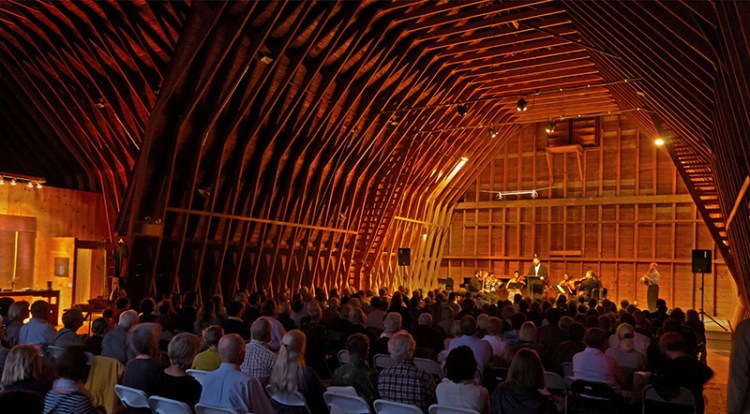DAMARISCOTTA — Driving through this small, attractive town and its scenic outskirts on the way to the opening concert of the Salt Bay Chamberfest at Darrows Barn on Tuesday evening, it’s clear what draws so many musicians from around the country to Maine every summer. Though the festivals these musicians have built around their summer idylls generally have impressive rosters, for sheer star power it’s hard to beat Salt Bay, now in its 22nd season.
Among the featured players this summer are the Brentano String Quartet, violinists Jennifer Koh and Jennifer Frautschi, cellist Peter Wiley – long a member of the Beaux Arts Trio and the Guarneri String Quartet – and Ignat Solzhenitsyn, an extraordinary pianist and conductor, and also the son of the Soviet dissident writer Aleksandr Solzhentisyn, about whom he will be giving a talk at the festival on Sunday.
There was also a treat for a lapsed New Yorker on Tuesday: Alan Gilbert, the music director of the New York Philharmonic, appeared as a violist in Arnold Schoenberg’s early string sextet, “Verklärte Nacht” (“Transfigured Night”).
The festival also gets points for thoughtful programming. The entire first half of its opening program was devoted to works by the Finnish composer Kaija Saariaho – a brave move, given that Saariaho’s notions of timbre, texture and tonality are undoubtedly challenging for some listeners (although her emotional, picturesque scoring often wins them over).
More importantly, the program’s works were connected in fascinating ways. Saariaho’s “Nocturne” (1994) for solo violin was linked with the Schoenberg, which closed the concert, in that both are evocations of the night. But the Schoenberg also had connections with another of the Saariaho scores, “Je Sens un Deuxième Coeur” (“I Feel a Second Heart”), a 2003 chamber work based on her second opera, “Adriana Mater.”
More about atmosphere than picture painting, “Nocturne” taxes a violinist’s resources, asking for single tones, bowed in a way that produces overtones that turn these notes into hazy chords, as well as the glassine sounds of artificial harmonics, and pitches that are more hinted at than asserted outright – as if they were electrical charges dancing around a power line. Koh gave the piece a focused, dazzling performance.
“Verklärte Nacht,” however, also embodies a narrative that makes the “night music” connection seem almost incidental. Inspired by a Richard Dehmel poem, the piece charts the emotional map of an evening walk during which a woman confesses to her new lover that shortly before she met him, she became pregnant with another man’s child, conceived when she had despaired of finding love, and was desperate to experience the joy of motherhood. Her man responds – in a section during which the dark, anxious harmonies that portray the woman’s tale become bright and even celebratory – that the warmth between them would transform the child into their own.
Saariaho’s “Adriana Mater” also charts the transformative power of an inconvenient pregnancy. In this case, a woman who was raped during wartime wonders whether the son she is raising will be like her, or like his violent father. The music here, scored for viola (Hsin-Yung Huang), cello (Kasja William-Olsson) and piano (Ieva Jokubaviciute) is not as overtly programmatic as Schoenberg’s, but its five movements, etched as they are in Saariaho’s blend of rich themes and edgy timbre combinations, capture the range of the woman’s emotions. The musicians, moving easily between its vital, sharply accented passages and its more bleakly introspective figures, gave the score a moving, virtuosic performance.
Between “Nocturne” and “Je Sens un Deuxième Coeur,” the Variation Trio – Koh, Huang and cellist Wilhelmina Smith, who is also the festival’s founder and artistic director – gave an equally powerful and varied account of Saariaho’s four-movement “Cloud Trio” (2009), which embraces both the mystery of “Nocturne” and the intensity of “Je Sens.”
Still, it was Schoenberg’s dramatic, almost Wagnerian 1899 score that proved the evening’s standout performance. The ensemble – violinists Jonathan Crow and Koh, violists Gilbert and Huang, and cellists Wiley and William-Olsson (who is married to Gilbert) – played with the vigor and warmth necessary to illuminate its underlying storyline, and the kind of precise but passionate interplay that, narrative aside, is simply top-drawer music making.
Allan Kozinn is a former music critic and culture writer for The New York Times who lives in Portland. He can be contacted at:
allankozinn@gmail.com
Twitter: kozinn
Send questions/comments to the editors.



Comments are no longer available on this story